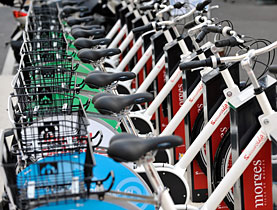Battery-assisted bikes boom in Switzerland

Electric bicycles have the wind in their sails – or sales: over the past two years manufacturers have found it hard to keep up with demand for the plug-n-ride bikes.
The number of e-bikes leaving the shops over the past few years has risen sharply, doubling each year from fewer than 6,000 in 2007 to nearly 24,000 in 2009. Sales were 10,000 more last year than for road bikes.
Almost every seventh bike sold in Switzerland today is power-assisted – remarkable considering the high price tag, starting at around SFr1,500 ($1,444) and going up to about SFr6,000 for more sophisticated models.
“Five years ago when we started, it was said that we sold bikes for lazy people or the elderly,” recalls Dominique Schönbächler, co-owner, along with Marc-Antoine Chavaillaz, of LocoEmotion, a shop specialising in e-bikes in Corcelles, in French-speaking canton Neuchâtel.
At first it was mostly women who were interested in these bikes. Today, customers are often men, young and fit as well. “There are fewer males pointing to their quadriceps and telling us that the electric bike is not for them,” Schönbächler says, smiling.
In 2009 Corcelles sold around 80 bikes – the same number that has already been bought in the first half of this year.
“It’s an incredible evolution. The electric bike is really suited for all purposes,” Chavaillaz said.
Bike to work
“In addition to environmental awareness, people are beginning to realise it can take them anywhere, especially in towns like Neuchâtel and Lausanne where the roads are steep, and it’s faster than other modes of transport during rush hour. Many people buy one to replace their motor scooter or second car.”
Schönbächler adds that health is another important factor. “We have less time to be physically active, so pedalling half an hour a day on the way to work enables you to get enough exercise to keep in shape.”
Propelling an e-bike does not mean pressing the on button and steering. The bike motor actually acts as a supplementary power source.
“The assistance is as little as 25 per cent and as great as 300 per cent in some models. In other words, the motor can provide a boost three times as big as that derived from pedalling,” Chavaillaz explained.
Battery charge
The technical evolution of e-bikes is another reason they have become so popular. The first lead batteries weighed between 10 and 15 kilograms and needed to be recharged after only 20 kilometres. Nowadays, lightweight (2.5-4kg) lithium batteries allow cyclists to travel around 60km.
The lifespan of the battery depends on how it’s used, but on average it’s three to four years or around 20,000km.
“It costs around SFr600 – SFr1,000 to replace the battery,” said Chavaillaz.
Faster models are also appearing on the market, which enable speeds up to 40-45km/h, and a greater distance range. Chavaillaz believes that people will soon begin to use them for longer commutes.
And it’s a cheap mode of transport, compared with other forms. It has been estimated that for a BionX battery and motor kit – which can be mounted on most bikes – a kilometre costs just 0.20 centimes in electricity plus 3.6 centimes in battery depreciation.
The run on e-bikes is such that manufacturers are having difficulty keeping up with demand. “For certain models you sometimes need to wait up to three months,” said Chavaillaz.
Sky-high sales
At the largest Swiss producer, Biketec, staff are working overtime to fulfil orders as quickly as possible. Biketec’s “Flyer” is selling like hot cakes, and company executives are planning to nearly double the size of its factory in the town of Huttwil in canton Bern to 15,500m². And this only a year after the plant went into operation.
The Swiss-made e-bike is also a success in Germany, the Netherlands and Austria.
“According to experts, sales of electric bikes should make up 30 per cent of all new bicycle sales in Switzerland, compared with 10-15 per cent today,” Kurt Schär, Biketec managing-director, told the Geneva business daily, L’Agefi.
In the Netherlands, the electric-bike has a 20 per cent market share, while it is only 4-5 per cent in Germany.
“One could say there’s a trend. The same was said during the mountain-bike boom but we’re still selling a lot of these,” notes Chavaillaz. The Corcelles owner is convinced that the future belongs to the e-bike.
“Low-impact mobility is a combination of various means of transport and the electric bike will be a full part of that.”
Daniele Mariani, swissinfo.ch (Translated from Italian by Dale Bechtel)
There are many types of electric-motorised bicycles using several technologies. They vary in cost and complexity and direct-drive and geared motor units are both used. An electric power-assist system may be added to almost any pedal cycle using chain drive, belt drive, hub motors or friction drive.
Electric bicycles use rechargeable batteries, electric motors and some form of control. This can be a simple as an on-off switch but is more usually an electronic pulse width modulation control.
Electric motorized bicycles can be power-on-demand, where the motor is activated by a handlebar mounted throttle, and/or a “pedelec” (from pedalelectric), where the electric motor is regulated by pedalling. These have a sensor to detect the pedalling speed, the pedalling force, or both.
Range is a key consideration with electric bikes, and is affected by factors such as motor efficiency, battery capacity, efficiency of the driving electronics, aerodynamics, hills and weight of the bike and rider. The range of an electric bike is usually stated as somewhere between 7 km (uphill on electric power only) to 70 km (minimum assistance) and is highly dependent on whether or not the bike is tested on flat roads or hills.
According to insurer, AXA Winterthur, e-bike riders are more prone to accidents. The danger lies in the fact that other road vehicles underestimate their speed.
In a crash test, a person riding an e-bike hitting an open car door at 40km/h suffers serious head and chest injuries. In the case of a normal bike speed, the car driver would have had time to close the door, or the bike rider would have been able to swerve out of harm’s way.
For this reason, AXA Winterthur has called for helmets to be mandatory for anyone riding a bike that can reach speeds up to 45km/h.

In compliance with the JTI standards
More: SWI swissinfo.ch certified by the Journalism Trust Initiative















You can find an overview of ongoing debates with our journalists here . Please join us!
If you want to start a conversation about a topic raised in this article or want to report factual errors, email us at english@swissinfo.ch.